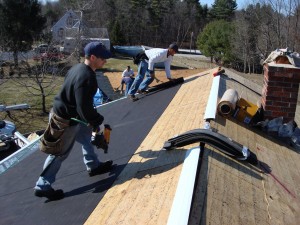 A while back we wrote an article that discussed different tips for examining the condition of your roof. This is typically a good thing to do in the early Fall, so that you have time to make any fixes to it before the Winter weather begins. In this article we’ll discuss some options you have if you’ve decided to replace your existing roof.
A while back we wrote an article that discussed different tips for examining the condition of your roof. This is typically a good thing to do in the early Fall, so that you have time to make any fixes to it before the Winter weather begins. In this article we’ll discuss some options you have if you’ve decided to replace your existing roof.
Before even making the decision to replace your roof you need to make sure that it is in need of being replaced. This depends on the existing roofing material and the weather. Asphalt shingles may need to be replaced as early as 15 years after installation. Wood and rubber tiles can usually last 30-50 years. Metal typically can last at least 50 years, and slate, one of the most durable roofing materials, typically lasts the lifetime of the house.
Like any other housing material, there is a direct relationship between price and durability/longevity of the material. In short, if you want something that’ll last longer you’ll need to pay more for it. This is why most Americans use asphalt shingles on their home. It’s cheap, easy to install and fairly resilient. They also come in a variety of colors, and asphalt shingles tens to look aesthetically appealing for many different home styles. If you’re an environmentalist though, you might want to avoid asphalt shingles because they’re not usually recyclable because of the layer of fiberglass added to the shingles.
Wood shingles and shakes allow for a variety of different wood styles (including cedar, redwood, pine and more). Wood shingles tend to be a little costlier than asphalt, but they do blend pretty well with most home styles, particularly ranch, cottages and contemporary-style homes. The big concern with wood is its low fire safety rating. This risk can be offset with a fire-resistant treatment, which usually comes with an additional cost
Slate, as mentioned above, tends to last forever (or at least as long as the house). Slate is also very environmentally friendly, since it is not only made from a sustainable mixture, but it’s also recyclable. However, it is expensive and very heavy, and it tends to only work well with Mediterranean, Mission and European-style homes. Also, keep in mind that it is often a darker color, so it’s not ideal for high-heat locations.
There are several other popular roofing options out there, including synthetic shingles, clay & concrete, metal and fiber cement. They all come with different price points, durability and colors. When choosing the right roofing material you’ll need to factor in your budget, as well as the style of your home. Of course, when installing or repairing your roof it’s always a good time to consider adding solar panels.
Greyhound General, a San Diego home remodeling contractor will help provide you with all the different options for your home and roof. If you have any questions about remodeling your home or roof, or if you’re interested in a free estimate please fill out the form here or call 800-568-7108.
